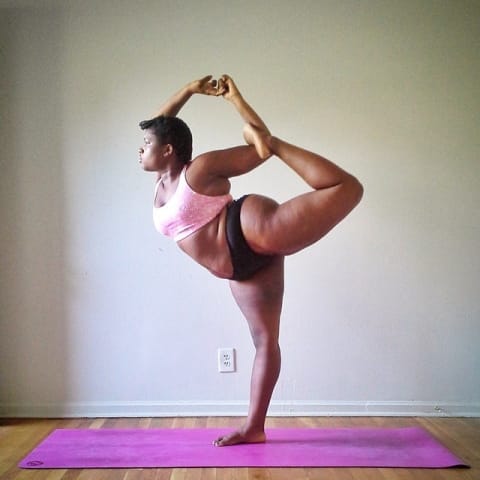Advertisement

As Western yoga practitioners, it is so easy for our priorities to slip and our practices to become more about materialism than holistic well-being and positive development. To borrow a common phrase, we’re talking the talk and not walking the walk.
Pose shaming is just straight up lame.
Here are six common signs that you might be practicing, not living, the yoga lifestyle:
1. You think ahimsa relates solely to your veganism.
How many times have I overheard a self-righteous Hermione Granger-style yoga student say something along the lines of: “Ahimsa is non-violence and that means you can’t eat meat.” Of course that’s a totally valid way to define ahimsa (the yama of non-violence), but non-violence is too broad a concept to simply stop at the food we eat.
Violence can manifest in myriad ways, and it usually comes in the form of verbal and mental slashes against ourselves and one another. And if every yoga practitioner put more energy toward broadening our definition of ahimsa, we might actually manifest more positivity in an otherwise violent world.
2. Your practice is based on how you treat yourself and NOT others.
I think we can all agree that Westerners are (generally speaking) pretty self-involved. Because yoga already requires practitioners to devote a substantial amount of energy to self-involvement, it’s very easy for us to become self-involved to the point of delusion. We can’t forget that our service to others is just as important as any service we give to ourselves.
There’s no singular way to practice a pose, because our bodies are all different.
3. You criticize others based on what their asana "should" look like.
Pose shaming is just straight up lame, and thanks to social media, it’s rampant in our community and is generally condoned by a number of yoga teachers. Honestly, I blame the competitive nature of the fitness world, in general. It’s not uncommon to hear a yoga student complain about their progress in a pose because it’s not as “good” as they “want.
All too often, we fail to recognize that every expression of an asana (pose) is just as “good” as the next. There’s no singular way to practice a pose, because our bodies are all different. Asana frequently looks and feels different for everyone. Belittling ourselves and one another is mean, short-sighted, and totally against the true meaning of yoga.

4. Your definition of a dedicated practice is cosmetic and superficial.
Your practice is not defined by the number of organic grocery stores you frequent and how many pairs of fancy yoga pants you own. These days, Western yoga is seemingly a rich person’s game. The massive revenue from yoga-related businesses is evidence enough. But it’s hard to find a space in our yoga world which hasn’t been slightly tarnished by capitalism.
Unfortunately, this leads to huge class divisions between yoga practitioners of varied socio-economic backgrounds, and this underlying classism restricts yoga’s image to be a frivolous sport for the wealthy.
We’re all capable of making mistakes and we’re all capable of showing compassion.
5. You are unable to feel compassion toward your fellow practitioner.
We all slip up in life — we all make mistakes and use bad judgement. Why then, is it so easy for us to point fingers at teachers and practitioners who make mistakes? Looking at Bikram Choudhury and John Friend’s falls from grace, it is amazing how many of my fellow yoga practitioners threw some crazy shade at these men.
I’m not saying their alleged mistakes were not substantial, but it is also critical that we remember the humanity of our brethren. We’re all capable of making mistakes and we’re all capable of showing compassion.
6. You think the “spiritual side” can be omitted from yoga.
It’s extremely common to hear Western yoga teachers make comments about how certain styles of yoga avoid the “spiritual stuff” in favor of good old-fashioned fitness. Does our fear of yoga’s “spiritual side” signal a latent fear of Eastern philosophy? Why are so many of us afraid to accept the deeper lessons of yoga?
What if we were to stop associating yogic spirituality with the polarizing aspects of religious spirituality? The spiritual lessons of yoga far exceed religion. By truly being open to everything a yoga practice can create and provide, we’ll be able to spread the power of yoga for generations to come.

Cover Photo by Lauren Perlstein for BANDIER, images courtesy of the author, via Instagram
Watch Next
Enjoy some of our favorite clips from classes
Enjoy some of our favorite clips from classes
What Is Meditation?
Mindfulness/Spirituality | Light Watkins
Box Breathing
Mindfulness/Spirituality | Gwen Dittmar
What Breathwork Can Address
Mindfulness/Spirituality | Gwen Dittmar
The 8 Limbs of Yoga - What is Asana?
Yoga | Caley Alyssa
Two Standing Postures to Open Up Tight Hips
Yoga | Caley Alyssa
How Plants Can Optimize Athletic Performance
Nutrition | Rich Roll
What to Eat Before a Workout
Nutrition | Rich Roll
How Ayurveda Helps Us Navigate Modern Life
Nutrition | Sahara Rose
Messages About Love & Relationships
Love & Relationships | Esther Perel
Love Languages
Love & Relationships | Esther Perel


















